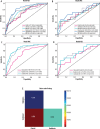Computed tomography radiomics combined with clinical parameters for hepatocellular carcinoma differentiation: a machine learning investigation
- PMID: 40321709
- PMCID: PMC12049157
- DOI: 10.5114/pjr/200631
Computed tomography radiomics combined with clinical parameters for hepatocellular carcinoma differentiation: a machine learning investigation
Abstract
Purpose: To evaluate the performance of a combined clinical-radiomics model using multiple machine learning approaches for predicting pathological differentiation in hepatocellular carcinoma (HCC).
Material and methods: A total of 196 patients with pathologically confirmed HCC, who underwent preoperative computed tomography (CT) were retrospectively enrolled (training: n = 156; validation: n = 40). The modelling process included the folowing: (1) clinical model construction through logistic regression analysis of risk factors; (2) radiomics model development by comparing 6 machine learning classifiers; and (3) integration of optimal clinical and radiomic features into a combined model. Model performance was assessed using the area under the curve (AUC), calibration curves, and decision curve analysis (DCA). A nomogram was constructed for clinical implementation.
Results: Two clinical risk factors (BMI and CA153) were identified as independent predictors of differentiated HCC. The clinical model showed moderate performance (AUC: training = 0.705, validation = 0.658). The radiomics model demonstrated improved prediction capability (AUC: training = 0.840, validation = 0.716). The combined model achieved the best performance in differentiating HCC pathological grades (AUC: training = 0.878, validation = 0.747).
Conclusions: The integration of CT radiomics features with clinical parameters through machine learning provides a promising non-invasive approach for predicting HCC pathological differentiation. This combined model could serve as a valuable tool for preoperative treatment planning.
Keywords: computed tomography; hepatocellular carcinoma; machine learning; pathological grading; radiomics.
© Pol J Radiol 2025.
Figures





Similar articles
-
Preoperative prediction for pathological grade of hepatocellular carcinoma via machine learning-based radiomics.Eur Radiol. 2020 Dec;30(12):6924-6932. doi: 10.1007/s00330-020-07056-5. Epub 2020 Jul 22. Eur Radiol. 2020. PMID: 32696256
-
Preoperative contrast-enhanced computed tomography-based radiomics model for overall survival prediction in hepatocellular carcinoma.World J Gastroenterol. 2022 Aug 21;28(31):4376-4389. doi: 10.3748/wjg.v28.i31.4376. World J Gastroenterol. 2022. PMID: 36159012 Free PMC article. Clinical Trial.
-
Machine learning based on clinico-biological features integrated 18F-FDG PET/CT radiomics for distinguishing squamous cell carcinoma from adenocarcinoma of lung.Eur J Nucl Med Mol Imaging. 2021 May;48(5):1538-1549. doi: 10.1007/s00259-020-05065-6. Epub 2020 Oct 15. Eur J Nucl Med Mol Imaging. 2021. PMID: 33057772 Free PMC article.
-
Prediction of initial objective response to drug-eluting beads transcatheter arterial chemoembolization for hepatocellular carcinoma using CT radiomics-based machine learning model.Front Pharmacol. 2024 Jan 25;15:1315732. doi: 10.3389/fphar.2024.1315732. eCollection 2024. Front Pharmacol. 2024. PMID: 38344175 Free PMC article.
-
Construction of nomogram model based on contrast-enhanced ultrasound parameters to predict the degree of pathological differentiation of hepatocellular carcinoma.Front Oncol. 2025 Jan 27;15:1519703. doi: 10.3389/fonc.2025.1519703. eCollection 2025. Front Oncol. 2025. PMID: 39931079 Free PMC article. Review.
References
-
- Jiang C, Cai YQ, Yang JJ, Ma CY, Chen JX, Huang L, et al. . Radiomics in the diagnosis and treatment of hepatocellular carcinoma. Hepatobiliary Pancreat Dis Int 2023; 22: 346-351. - PubMed
-
- Greten TF, Villanueva A, Korangy F, Ruf B, Yarchoan M, Ma L, et al. . Biomarkers for immunotherapy of hepatocellular carcinoma. Nat Rev Clin Oncol 2023; 20: 780-798. - PubMed
-
- Ozer Etik D, Suna N, Boyacioglu AS. Management of hepatocellular carcinoma: prevention, surveillance, diagnosis, and staging. Exp Clin Transplant 2017; 15: 31-35. - PubMed
LinkOut - more resources
Full Text Sources
